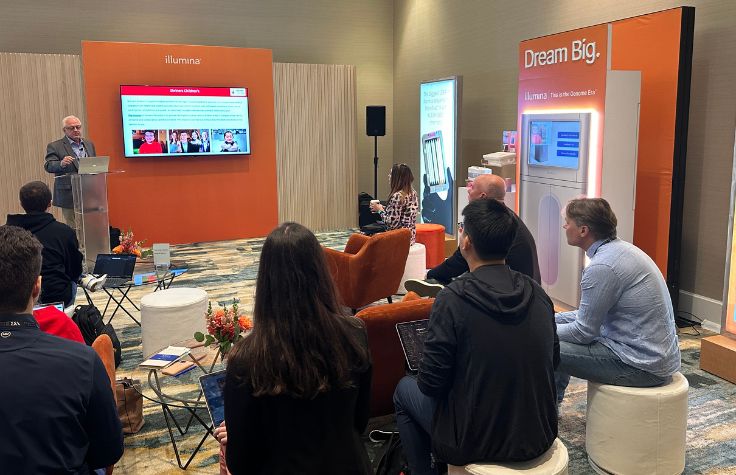
15 February 2024
At the recent Advances in Genome Biology and Technology (AGBT) conference in Orlando, Florida, Illumina had eight posters accepted (titles below). Researchers were proud to showcase their studies and to collaborate with other scientists and customers.
One poster, “Deeper characterization of immune repertoire diversity observed with longer read sequencing and SBS accuracy improvements,” dives into the newer field of immune repertoire profiling. “It’s really important in a lot of areas of medicine, like cancer, and in the understanding of how the immune system works,” says Illumina Director of Systems Integration Carolyn G. Conant, one of the study’s authors.
A person’s immune repertoire is the library of antibodies and receptors their adaptive immune system has made to recognize specific pathogens. If a biologist can know a person’s baseline repertoire, it’s possible to monitor when their immune system has encountered new forms of disease. Conant explains that a hypothetical patient, having completed chemotherapy or treatment for an infection, might be feeling better and think they’re in remission, but that may not be the case.
With the recent conversion to XLEAP-SBS chemistry on the Illumina NextSeq 1000 and NextSeq 2000 Systems, the data quality on these very long sequencing reads helps researchers discover more of the different types of immune cells present. “It allows you to have a snapshot of the immune system at any point in time,” says Cande Rogert, Illumina VP, Global Head of Advanced Science and a fellow author.
The authors on the poster are Conant, Rogert, Michael Morikado, and Robin Bombardi from the Illumina Core R&D group in San Diego, as well as Alix Kwasniewska, Ilaria Grizzi, Tim Merkel, and Camilla Colombo from Illumina Core R&D in Cambridge, United Kingdom.
Another study summarized in a poster, “Improvements in variant calling performance in human genome trios on XLEAP-SBS chemistry with onboard DRAGEN 4.2 analysis,” highlights a powerful trifecta available soon on the NextSeq 1000 and 2000: the P4 flow cell, XLEAP-SBS chemistry, and secondary analysis through DRAGEN 4.2. This is also the first time Illumina is delivering high-quality trios at 40× coverage.
Using a model trio sample—a mother, father, and their child who is ill—the study authors were able to test the depth and quality of whole-exome and whole-genome sequencing. Thanks to the higher density P4 flow cell and the new XLEAP-SBS chemistry, researchers can now run three whole human genomes at once and perform variant calls at extremely high accuracy.
XLEAP-SBS on the P4 flow cell with DRAGEN 4.2 resulted in strong variant calling performance above 99.8% for SNV precision and recall, and for indel precision and recall for the model trio at 40× coverage. “The precision and recall for the SNVs and indels is really high,” Conant says. “We had to rewrite our metrics thresholds for this program because they were so much better than the previous version of the platform.”
Analysis of the model trio’s genomic data produced 98.44% Mendelian consistent genotypes and only 1.56% Mendelian error genotypes. “That’s a measure of how accurate we are when you’re looking at the mom, the dad, and the child. It’s extremely, extremely accurate,” Conant explains. Our variant calling is equivalent to our high-throughput platforms now. It is a major achievement to hit that level of accuracy in variant calling.”
“And all that was achieved through the new release of the flow cell, XLEAP-SBS chemistry, and the software,” Rogert adds. “With DRAGEN 4.2 running onboard a benchtop sequencer, we’re able to get three high-quality whole genomes. This is opening up a lot of applications for the benchtop, and with excellent data quality.”
Now that the NextSeq 1000 and 2000 Systems perform with shorter run times, significant error rate reduction, and an increase in total output (up to 500 gigabases), Illumina is broadening access for regions or institutions that may not be able to afford a high-throughput system.
Rogert and Conant are credited on the poster along with Illumina Core R&D colleagues Michael Morikado, Alix Kwasniewska, Ilaria Grizzi, Tim Merkel, and Camilla Colombo.
In total, eight Illumina posters were accepted at AGBT. Illumina proudly recognizes all scientists who contributed to them:
- “Interrogating the dark regions of the genome with targeted long reads”
- “Highly multiplexed protein measurements using SOMAmers® with a NGS readout”
- “DRAGENTM Build-Your-Own multigenome (Graph) (BYOG) reference from assemblies: The human pangenome reference consortium case of study”
- “Sensitive, distributable, and cost-effective molecular residual disease testing using whole genome cell free DNA sequencing”
- “WGS improves variant detection yield in FFPE samples over WES”
- “Enhancing somatic mosaic variant detection with the DRAGEN™ pipeline – expanding the personal genome to clinically relevant low AF variants”
- “Deeper characterization of immune repertoire diversity observed with longer read sequencing and SBS accuracy improvements”
- “Improvements in variant calling performance in human genome trios on XLEAP-SBS™ chemistry with onboard DRAGEN™ 4.2 analysis”
To learn more from our 2024 AGBT announcements webinar, click here.


